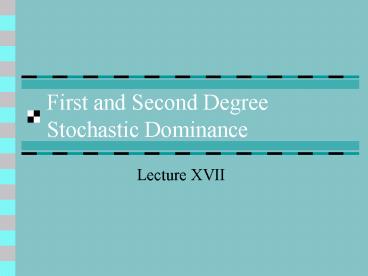First and Second Degree Stochastic Dominance - PowerPoint PPT Presentation
1 / 17
Title:
First and Second Degree Stochastic Dominance
Description:
... that utility is nondecreasing in income, or the decision maker prefers more ... Building on FSD, second degree stochastic dominance SSD invokes risk aversion by ... – PowerPoint PPT presentation
Number of Views:1137
Avg rating:3.0/5.0
Title: First and Second Degree Stochastic Dominance
1
First and Second Degree Stochastic Dominance
- Lecture XVII
2
The Concept of an Efficiency Criteria
- An efficiency criteria is a decision rule for
dividing alternatives into two mutually exclusive
groups efficient and inefficient. - If an alternative is in the efficient group, then
it is one that an investor may choose. - An inefficient investment will not be chosen by
any investor regardless of individual risk
preferences.
3
- From an economic standpoint, the criteria should
be related to general notions of utility or
preferences. - In general, the more global the preference, the
less discerning the criteria (i.e. the fewer
alternatives eliminated). - A smaller efficient set requires more stringent
requirements on preferences.
4
- The most general efficiency criteria relies only
on the assumption that utility is nondecreasing
in income, or the decision maker prefers more of
at least one good to less. - FSD Rule Given two cumulative distribution
functions F and G, an option F will be preferred
to the second option G by FSD independent of
concavity if F(x) ? G(x) for all return x with at
least one strict inequality.
5
- Intuitively, this rule states that one
alternative F will dominate G if its cumulative
distribution function always lies to the left of
Gs
6
- Mathematically, FSD is dependent on the integrals
of the utility function times each alternative
distribution function
7
- Note that the utility function is the same for
each investment alternative, but the distribution
function changes. If investment F dominates
investment G, then the difference, D, defined as
8
- Integrating by parts
9
- Second Degree Stochastic Dominance
- Building on FSD, second degree stochastic
dominance SSD invokes risk aversion by inferring
that the utility function is concave, implying
that the second derivative of the utility
function is negative. - SSD Rule A necessary and sufficient condition
for an alternative F to be preferred to a second
alternative G by all risk averse decision makers
is that
10
(No Transcript)
11
(No Transcript)
12
- Graphically, another explanation of SSD can be
determined by Alternative F dominates
alternative G for all risk averse individuals if
the cumulative area under F exceeds the area
under the cumulative distribution function G for
all values x, or if the cumulative area between F
and G is non-negative for all x.
13
Table 1. Crop Yields
14
Table 2. Comparison of CDFs
15
(No Transcript)
16
Table 3. Comparison of Areas Under CDFs
17
Second Degree Stochastic Dominance































